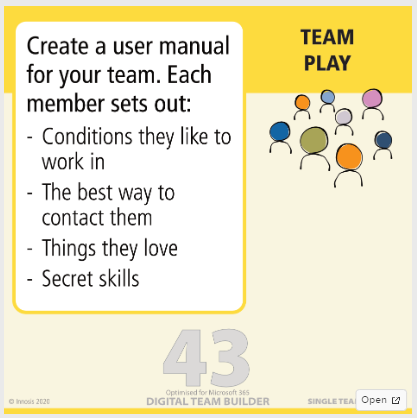By Janus Boye
The shift to digital teams is here to stay, whether we stay remote or return to the office in a hybrid/mixed mode of work. And whilst digital teamworking tools, such as Microsoft Teams, allow us to continue working, we can easily focus on meetings and chat - not the elements that drive high performing and collaborative teams.
In a recent member call, UK-based collaboration expert Andrew Pope showed how his approach to designing blended teams has been adopted by a UK Government client.
We looked at how they found opportunities and set goals, what techniques were selected using a 'choose your own adventure' approach via online workshops and game cards and how they helped their workforce learn new skills to embrace digital teamworking, to fully utilise Microsoft Teams.
Below I’ve shared a few of my notes from the call. Further down, you can also find slides, screenshots and the entire recording from the call alongside links for additional reading.
Let’s start with the people and the problem we are trying to solve.
Find out what’s not working
Early on in the call, Andrew shared a memorable quote from one of his recent client meetings which resonated with most:
“The tools are working, but we are swamped with meetings”
To get things moving, Andrew recommended focusing on what’s not working. Surface the blockers and the different things that are holding back collaboration. To just mention two from recent workshops, Andrew pointed to:
Tool overload: The good old: “Which-tool-when” problem is more relevant and ever with forced working from home
Fear of being seen: This doesn’t relate to actually being seen in person, but a concern with working out loud and sharing unpolished drafts.
Playing a game to improve teamworking
Andrew also brought an impressive Mural (digital whiteboard tool) board to the call, which represented a board game approach to further improve collaboration.
The board that Andrew showed during the call
With playing cards organised in categories like:
Quick wins
Team play
A voice for all
Make meetings work
Cards were split into two groups: strategies, that can help longer-term changes, and tactics/techniques, which are simple actions and new habits aimed at individuals and teams to enact straight away.
These could then be placed on the different boards to both point to challenges and potential solutions.
Sharing stories is a key part of the game. By selecting cards in response to the goals and blockers, it gets participants talking openly about why they feel a particular card could work and how they will use it - a big step in developing new skills.
If you are interested in more details on the game, here are the cards as shown in the session: Introducing digital team builder
Creating a user manual for your team
As Andrew said during the call:
If we don’t work well in the analog world, we also don’t work well in the digital
As he quickly reviewed some of the action cards, he pointed to ‘Creating a user manual for your team’ as one of his favourites and a popular choice.
It gives individuals an opportunity to express their preferences on how they like to work and for the team to agree on some common working techniques. When we moved to digital teamwork, many of us didn't look to establish ways of working and as such, expectations have not been clear, leading to a default 'always on' where we are at our machines responding to multiple communication channels. To quote Andrew:
User Manuals allow us to reassert control over our days by establishing some simple principles.
Learn more about digital teamworking
For additional reading on the subject, a few links were circulated in the chat during the call:
Google’s work with high performing teams including psychological safety
Andrew’s recent article on building digital skills for blended working
You can also browse the slides from the call and finally, do lean back and enjoy the entire 26-minute recording below:


